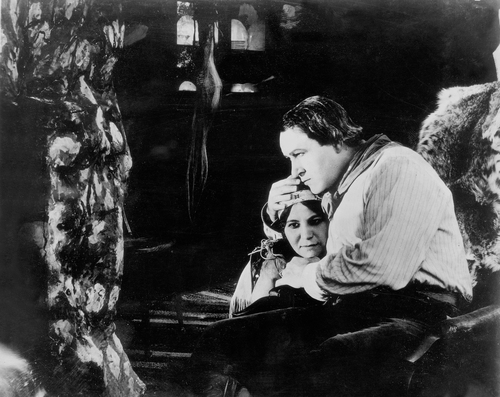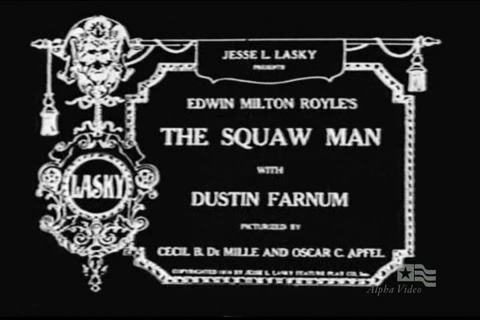The Squaw Man (known as The White Man in the UK) is a 1914 silent western drama motion picture starring Dustin Farnum. Directed by Oscar Apfel and Cecil B. DeMille and produced by DeMille and Jesse L. Lasky, the screenplay was adapted by DeMille and Apfel from the 1905 stage play, The Squaw Man, written by Edwin Milton Royle.
This first screen version of the story was the legendary DeMille's first movie assignment. It also holds the distinction of being the first feature-length movie filmed specifically in Hollywood (although not the first to be made in the Los Angeles area...). Harbor scenes were shot in San Pedro, California and the western saloon set was built beside railroad tracks in the San Fernando Valley. Footage of cattle on the open range were shot at Keen Camp in Idyllwild, California, while snow scenes were shot at Mount Palomar. The Squaw Man went on to become the only movie successfully filmed three times by the same director/producer, DeMille. He did a silent remake in 1918, and a talkie version in 1931.
Cast
- Dustin Farnum ... Capt. James Wynnegate aka Jim Carston
- Monroe Salisbury ... Sir Henry, Earl of Kerhill (uncredited)
- Red Wing ... Nat-u-ritch (uncredited)
- Winifred Kingston ... Lady Diana, Countess of Kerhill (uncredited)
- 'Baby' Carmen De Rue ... Hal (uncredited)
- Joseph Singleton ... Tab-y-wana (uncredited)
- William Elmer ... Cash Hawkins (uncredited)
- Mrs. A.W. Filson ... The Dowager Lady Elizabeth Kerhill (uncredited)
- Haidee Fuller ... Lady Mabel Wynnegate (uncredited)
- Foster Knox ... Sir John (uncredited)
- Dick La Reno ... Big Bill (uncredited)
- Richard L'Estrange ... Grouchy (uncredited)
- Fred Montague ... Mr. Petrie (uncredited)
- Cecil B. DeMille ... Faro Dealer (uncredited)
- Cecilia de Mille ... Child (uncredited)
- Hal Roach ... Townsman (uncredited)
- Art Acord ... Townsman (uncredited)
- Raymond Hatton ... Bit part (uncredited)
"...the story of miscegenation in the Old West was supposed to have been filmed on locations near Flagstaff, Arizona. Young Cecil B. DeMille, who was to share directorial duties with veteran stage performer Oscar Apfel, and the Lasky crew arrived in the middle of a storm and decided to remain on the train until the final destination. Debarking in sunny Los Angeles, the Lasky people rented half of a barn in the suburb of Hollywood where the Squaw Man finally went before the camera on December 29, 1913. The finished 6-reel-long melodrama thus became the first feature western to be shot entirely in Hollywood. The result is a terribly dull but typical Victorian romance about a English peer (Dustin Farnum) falsely accused of a crime actually committed by his brother. He escapes to the American West and marries an Indian maiden (Red Wing). Years later, on his deathbed, the brother confesses, thus freeing the hero to reclaim title and lands. The Indian wife, meanwhile, has conveniently murdered someone and is herself killed, leaving the Englishman able to return to home and hearth without suffering the embarrassment of being called a "Squaw Man." DeMille remained strangely sentimental about this -- his screen debut -- and filmed the play twice more, in 1918 starring Elliott Dexter, and again in 1931 starring Warner Baxter. The story didn't improve with age. The location of the now-famous Lasky barn, on Selma Avenue near Vine Street, became the headquarters of Paramount when Lasky merged with competitor Adolph Zukor. It remains today as the oldest film company located in geographical Hollywood. Always on the verge of being torn down, the old barn later saw duty as a gymnasium and, later still, was the train depot in the Bonanza television series. In the 1980s, the barn was moved to a new location on Odin Street near the Hollywood Bowl and functioned as a studio museum."
DOWNLOAD
(Silent, black & white Divx, 1:20, as multi-part rar-file):
PART 01 (95 MB)
PART 02 (95 MB)
PART 03 (95 MB)
PART 04 (95 MB)
PART 05 (95 MB)
PART 06 (95 MB)
PART 07 (95 MB)
PART 08 (95 MB)
PART 09 (95 MB)
PART 10 (12 MB)
The Squaw Man; a novel by Julie Opp Faversham:
adapted from the play by Edward Milton Royle (1906)
DOWNLOAD (29 MB pdf) from archive.org.
Read about
The Controversy Over the Word 'Squaw'



Keine Kommentare:
Kommentar veröffentlichen